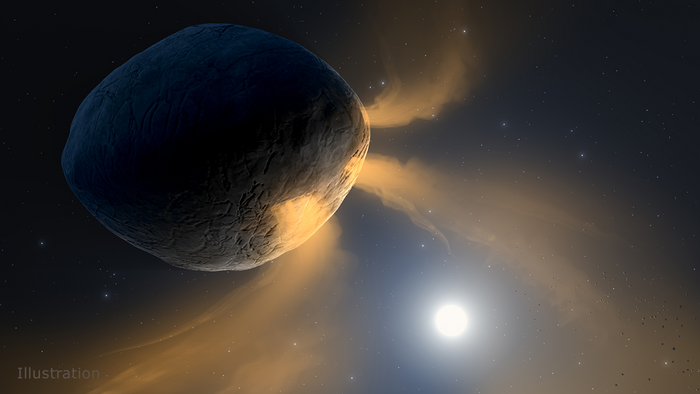
Study sheds new light on mysterious asteroid Phaethon
A recent study has revealed that the mysterious comet-like tail of asteroid 3200 Phaethon, the source of the annual Geminid meteor shower, is not composed of dust as previously believed. Instead, the tail consists of sodium gas, challenging long-held scientific assumptions about this enigmatic celestial object.
Discovered in 1983, Phaethon is an asteroid that exhibits comet-like behavior, brightening and forming a tail when near the Sun. Most meteor showers are the result of comets, so when scientists found that Phaethon’s orbit matched that of the Geminid meteors, they assumed the tail was formed by dust escaping from the asteroid’s surface due to the Sun’s heat. In 2009, NASA’s Solar Terrestrial Relations Observatory (STEREO) confirmed the existence of Phaethon’s tail, supporting the dust theory.
However, in 2018, NASA’s Parker Solar Probe observed that the Geminid debris trail contained far more material than Phaethon could possibly shed during its close approaches to the Sun. This prompted Qicheng Zhang, a PhD student at the California Institute of Technology and lead author of the study published in the Planetary Science Journal, to question the dust hypothesis.
“Comets often glow brilliantly by sodium emission when very near the Sun, so we suspected sodium could likewise serve a key role in Phaethon’s brightening,” explained Zhang.
To test this hypothesis, Zhang examined images from the Solar and Heliospheric Observatory (SOHO), a joint mission between NASA and the European Space Agency (ESA), which has color filters that can detect sodium and dust. Archival images from STEREO and SOHO were also examined, revealing the tail during 18 of Phaethon’s close solar approaches between 1997 and 2022.
SOHO’s observations showed the asteroid’s tail to be bright in the filter that detects sodium but not in the filter that detects dust. The shape of the tail and the way it brightened as Phaethon passed the Sun also matched what scientists would expect if it were composed of sodium, but not if it were composed of dust. This evidence confirmed that Phaethon’s tail is made of sodium, not dust.
Project team member Karl Battams of the Naval Research Laboratory highlighted the significance of the discovery. “Not only do we have a really cool result that kind of upends 14 years of thinking about a well-scrutinized object, but we also did this using data from two heliophysics spacecraft – SOHO and STEREO – that were not at all intended to study phenomena like this.”
The researchers suspect that some of the comets discovered by SOHO and the citizen scientists involved in the Sungrazer Project may actually be rocky asteroids like Phaethon, heated up by the Sun. “A lot of those other sunskirting ‘comets’ may also not be ‘comets’ in the usual, icy body sense, but may instead be rocky asteroids like Phaethon heated up by the Sun,” said Zhang.
A lingering question remains: If Phaethon doesn’t shed much dust, how does it supply the material for the Geminid meteor shower observed each December? Zhang’s team theorizes that a disruptive event a few thousand years ago, possibly involving a piece of the asteroid breaking apart under rotational stress, caused Phaethon to eject the estimated billion tons of material that make up the Geminid debris stream. The exact nature of this event is still unknown.
Further answers may be forthcoming from the Japan Aerospace Exploration Agency (JAXA)’s upcoming DESTINY+ mission, which plans to fly past Phaethon later this decade.
More about comets and asteroids
Comets and asteroids are celestial objects found within our solar system, often referred to as small Solar System bodies. While both are remnants of the early solar system, they differ in their composition, structure, and behavior.
Comets are made up of a mixture of ice, rock, and dust, and are sometimes referred to as “dirty snowballs.” They are believed to originate from the Kuiper Belt and the Oort Cloud, regions located in the outer reaches of the Solar System. When a comet gets close to the Sun, the ice in its nucleus vaporizes, creating a glowing coma (a bright, hazy atmosphere) and a tail that can stretch millions of kilometers. The tail always points away from the Sun due to the solar wind and radiation pressure. Comets typically have elongated, elliptical orbits, which cause them to periodically visit the inner Solar System.
Asteroids, on the other hand, are primarily composed of rock and metal and are the remnants of the early Solar System’s building blocks. They are found mostly in the Asteroid Belt, located between the orbits of Mars and Jupiter, although some can be found in other parts of the Solar System as well. Unlike comets, asteroids do not have a glowing coma or a tail, as they do not contain significant amounts of ice. Their orbits are generally more circular than those of comets, and they can range in size from a few meters to hundreds of kilometers in diameter.
While comets and asteroids are distinct celestial objects, some “crossover” bodies exhibit characteristics of both, such as asteroid 3200 Phaethon, which forms a comet-like tail when near the Sun. The study of these celestial objects helps scientists understand the formation and evolution of the Solar System and offers insights into the potential origins of life on Earth.
Image Credit: NASA/JPL-Caltech/IPAC
—-
Check us out on EarthSnap, a free app brought to you by Eric Ralls and Earth.com.












